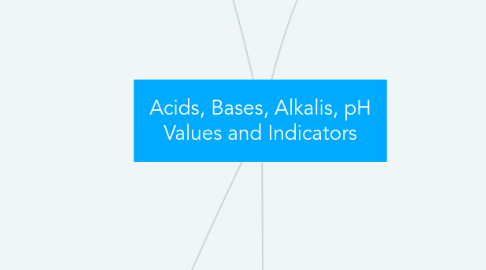
1. Acids
1.1. Chemical Properties
1.1.1. On the other hand, some may be too reactive to be experimented with, e.g. sodium.
1.1.2. Some metals that are unreactive such as copper, silver, and gold will not react with acids as they are the lowest in the reactivity series.
1.1.3. react with METAL CARBONATES to form salt, water and carbon dioxide.
1.1.3.1. After a metal carbonate and an acid have reacted in a test tube, a funnel with a blocker can be placed into another test tube with limewater in it to test for carbon dioxide. A white precipitate will form in the test tube with limewater and effervescence can be observed.
1.1.4. react with METALS, which are above hydrogen in the reactivity series, to form a salt and hydrogen gas
1.1.4.1. A lighted splint can be placed in a test tube that an acid and a metal have reacted in to be tested for hydrogen gas. When give sufficient time for the hydrogen to accumulate, a lighted splint will make a pop sound when placed inside the test tube and H2O will be formed. Effervescence can be observed.
1.1.5. Contain Hydrogen ions
1.2. Physical Properties
1.2.1. pH > 7
1.2.2. SOUR Taste
1.2.3. Turns moist BLUE litmus paper RED
1.2.4. Able to conduct electricity when dissolved in water
1.3. DEFINITION OF AN ACID
1.3.1. An acid is a substance that DISSOCIATES in water to produce hydrogen ions.
1.4. Examples of Acids
1.4.1. Vinegar contains ethanoic acid
1.4.2. Citrus fruits contain citric acid
1.4.3. Soft drinks contain carbonic acid
1.4.4. Yoghurt contains lactic acid
2. Indicators
2.1. Indicators can be used to test for the presence of acids or alkalis.
2.2. An indicator is a substance that has different colours in acidic and alkaline solutions.
2.3. LITMUS PAPER
2.3.1. Litmus paper can only show if a substance is alkaline or acidic. It cannot show the degree of acidity or alkalinity.
2.4. Common Indicators
2.4.1. At every particular pH value, ex. pH 1, pH 2, pH 3, 1 colour change can be observed. Most indicators have a different color for an acidic solution and an alkaline solution.
2.4.2. Natural Indicators
2.4.2.1. Natural indicators include leaves like red spinach and red cabbage, flowers like hibiscus flowers, and fruits like berries.
2.5. UNIVERSAL INDICATOR
2.5.1. Contains a mixture of dyes and can come in the form of pH papers or a solution.
2.5.2. Changes color according to the acidity and alkalinity of a particular solution, between the pH range of 0-14. The color given by the universal indicator can be compared to a color chart which can tell us the pH value of the solution.
2.5.3. COLOURS OF THE UNIVERSAL INDICATOR
2.5.3.1. Strong ACID: RED NEUTRAL solution: Green Strong ALKALI: Purple
3. Bases and Alkalis
3.1. Bases
3.1.1. Bases like Calcium Hydroxide or Calcium oxide are used by farmers to neutralize excessive amounts of acid in soils that become too acidic because of chemical fertilizers or acidic rain.
3.2. The relationship between a base and an alkali
3.2.1. Bases are METAL OXIDES and METAL HYDROXIDES.
3.2.2. An alkali is a base that is soluble in water.
3.3. Alkalis
3.3.1. An alkali is an aqueous solution that contains hydroxide ions. All alkalis contain OH- ions.
3.3.2. Physical Properties
3.3.2.1. BITTER tasting and SOAPY to touch
3.3.2.2. Turns moist RED litmus paper BLUE
3.3.2.3. pH > 7
3.3.2.4. CONDUCTS ELECTRICITY when dissolved in water
3.3.3. Chemical Properties
3.3.3.1. On heating, Alkalis react with AMMONIUM SALT to form SALT, WATER, and AMMONIA
3.3.4. KEY TERM: NEUTRALISATION
3.3.4.1. ACIDS react with METAL OXIDES AND METAL HYDROXIDES to form SALT and WATER.
3.3.4.2. When acid and an alkali come into contact with each other, they neutralize each other.
3.3.4.3. Alkalis are used in many ways to neutralize excessive amounts of acid such as being used in our toothpaste, in our cleaning products, and even in medicine.
4. pH
4.1. The acidity or alkalinity of a solution can be measured on a scale known as the pH scale.
4.2. The pH value of a solution can be shown as a number that ranges from 0-14.
4.3. pH values
4.3.1. A solution with a pH value of less than 7 is an acidic solution.
4.3.1.1. The lower the pH value, the more acidic a solution is. This results in a higher number of hydrogen ions present when the pH value is lower.
4.3.2. A solution with a pH value of more than 7 is an alkaline solution.
4.3.2.1. The higher the pH value, the more alkaline a solution is. This results in a lower concentration of hydrogen ions. Instead, a higher amount of hydroxide ions are present.
4.3.3. A solution with a pH value equal to 7 is a neutral solution.
4.3.4. pH values can be applied to things everywhere. Substances in the body have different pH values. They can range from the acidic conditions in the stomach(around pH ~ 1.5) to the alkaline conditions in the small intestines(pH ~ 8.5) Hair itself is also weakly acidic at pH ~ 5.5.
4.3.5. Certain pH values allow for different types of plant growth, and microorganisms that spoil food tend to not do so well in solutions with low pH.
4.4. pH Meter
4.4.1. Indicators are only able to provide estimated values
4.4.2. a pH meter contains a probe that can be put into solutions of unknown pH.
4.4.2.1. Allows for a more accurate value to be determined.

